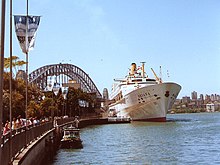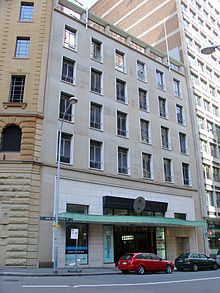Orient Steam Navigation Company

The Orient Steam Navigation Company , also known as Orient Line , was a British liner shipping company. The company's roots stretch back to the late 18th century. At the beginning of the 20th century, a collaboration began with the Peninsular and Oriental Steam Navigation Company (P&O), which took over the company completely in the 1960s.
history
1797-1900
The origins of the company lie in the business as a ship broker founded by James Thomson in 1797 . In 1828 James Anderson joined the business. The company maintained a fleet of smaller sailing ships, the operation of which had expanded into a worldwide liner business by the mid-19th century. From 1863 the company traded as Anderson, Thomson and Company , which changed in 1866 with the introduction of the liner service to Australia to Orient Line of Packets , mostly called Orient Line . The switch to steam ships resulted in another renaming of the company, Orient Steam Navigation Company .
1900-1939
The cooperation with the Peninsular and Oriental Steam Navigation Company began around 1900, when both shipping companies signed a joint contract with the Australian government for a postal service. Both companies had biweekly departures from Great Britain to Australia , which resulted in weekly ship connections with fast mail ships . During this period the Orient Line in rapid succession had built ever larger ships, whose names only with O began. In 1909, for example , a quintet of 12,000 tons was put into service with the ships Otway , Osterley , Orsova , Otranto and Orvieto . During the First World War, the ships were used for military service, some of which were lost. In the last year of the war, P&O took over the majority stake in the Orient Line, but let it operate independently until the 1960s. After the end of the war, the England-Australia service was resumed from 1919 and the company's own fleet was reinforced with the purchase of some formerly German ships from the British government's reparations portfolio. Later, in the second half of the 1920s, a number of new ships were added, mostly from the Vickers-Armstrongs shipyard in Barrow-in-Furness . Another series of ships was ordered from the mid-1930s after the shipping company was able to operate profitably again at the end of the global economic crisis .
1940-1960
Also in the Second World War , all ships of the Orient Line were used again by the British government. Of the eight ships used, four were lost during the war, the remaining four resumed the interrupted postal service between Great Britain and Australia from 1947. Due to the slow onset of economic recovery, it was not until 1948 to 1954 that the three new 28,000-ton ships Oronsay , Orcades and Orsova were brought back into service.
The higher speed of the new buildings made it possible to reduce the travel time by eight days to 28 days. The age of air travel, which began in the 1950s, began to increasingly decimate the market share of classic liner shipping, which is why the ships were used more and more often for part of the year on cruises or other employment was sought for them. The Oronsay began a transpacific service from 1954. Despite everything, both P&O and Orient Line each ordered one last larger ship. The P&O received its Canberra , the Orient Line put the Oriana into service. They were the largest and fastest passenger liners ever used on the England-Australia route. The Oriana reached speeds of up to 30 knots and thus reduced the duration of the journey from 28 to 21 days. Nevertheless, they could not stop the decline of the liner passenger services and were used as pure cruise ships from 1974.
1960-2005
The Oriana was the last newbuild of the Orient Line, and also the last ship to sail under the Orient Line flag. P&O and Orient Line merged in 1960 to form P&O Orient Lines . In 1964, the Orient Line color sample with the cream-colored hull was dropped in favor of the P & O's white exterior and the Orcades and Oronsay were also incorporated into the P & O fleet. The name Orient Line was not dropped until 1966, when the Orsova and the Oriana were also transferred to the P&O fleet. However , on her last voyage, before she was decommissioned in March 1986 , the Oriana carried the flag of the Orient Line again. After that, the last relic of the Orient Line survived an additional nineteen years as a floating tourist attraction before it was finally scrapped in China in 2005. However, the name Oriana was used again in memory of the former flagship of Orient Line on the P&O cruise ship built in 1995 at the Meyer shipyard .
Orient Line passenger ships
| year | Surname | tonnage | shipyard | Status / fate |
|---|---|---|---|---|
| 1877 ( 1871 ) | Garonne (I) | 3876 GRT | Robert Napier & Sons , Govan | 1871: PSNCo / 1878: Orient Line / 1897 sold to F. Waterhouse, Seattle |
| 1877 ( 1871 ) | Lusitania | 3877 GRT | Laird Brothers , Birkenhead | 1871: PSNCo / 1877: Orient Line / 1900 sold to Beaver Line |
| 1878 ( 1871 ) | Chimborazo | 3847 GRT | John Elder & Company, Govan | 1871: PSNCo / 1878: Orient Line / 1894 sold to P. Pitcher Cleopatra |
| 1878 ( 1871 ) | Cuzco | 3898 GRT | John Elder & Company, Govan | 1871: PSNCo / 1878: Orient Line / 1905 demolished in Genoa |
| 1879 | Orient | 5386 GRT | John Elder & Company, Govan | 1910 demolished in Genoa |
| 1882 | Austral | 5524 GRT | John Elder & Company, Govan | 1902 demolished in Genoa |
| 1887 | Ormuz (I) | 6031 GRT | Fairfield Shipbuilders , Govan | 1912 sold to Compagnie de Navigation Sud-Atlantique , Divona |
| 1891 | Ophir | 6910 GRT | Robert Napier & Sons, Govan | 1918 sold to the Admiralty (hospital ship) / 1921 demolished in Troon |
| 1899 | Omrah | 8130 GRT | Fairfield Shipbuilders, Govan | Sunk in 1918 by a German submarine |
| 1902 | Orontes (I) | 9023 GRT | Fairfield Shipbuilders, Govan | 1925 demolished in Inverkeithing |
| 1909 | Otranto (I) | 12,124 GRT | Workman, Clark , Belfast | 1918 after collision with the Kashmir fell |
| 1909 | Orsova (I) | 12,036 GRT | John Brown & Company , Clydebank | 1936 out of service and demolished |
| 1909 | Otway | 12,077 GRT | Fairfield Shipbuilders, Govan | Sunk in 1917 by a German submarine |
| 1909 | Orvieto | 12,133 GRT | Worman, Clark, Belfast | 1931 demolished in Bo'ness |
| 1909 | Osterley | 12,129 GRT | London & Glasgow Shipbuilding Company, Govan | 1930 demolished in Bo'ness |
| 1911 | Orama (I) | 12,927 GRT | John Brown & Company, Clydebank | Sunk in 1917 by a German submarine |
| 1917 | Ormonde | 14,853 GRT | John Brown & Company, Clydebank | 1952 demolished in Dalmuir |
| 1919 ( 1897 ) | Omar | 10,566 GRT | AG Vulcan Stettin , Bredow | 1897: NDL , ex- Queen Luise / 1919: Orient Line, renamed Omar in 1921 / Edison sold in 1924 |
| 1921 ( 1906 ) | Orcades (I) | 9630 GRT | AG Vulcan Stettin, Bredow | 1906: NDL, ex- Prince Ludwig / 1921: Orient Line, Orcades / 1924 out of service |
| 1924 | Orama (II) | 19,777 GRT | Vickers , Barrow-in-Furness | 1940 sunk in the North Sea by German warships |
| 1925 | Oronsay (I) | 20,043 GRT | John Brown & Company, Clydebank | Sunk in 1942 by an Italian submarine |
| 1926 | Otranto (II) | 20,026 GRT | Vickers-Armstrong, Barrow-in-Furness | 1957 demolished in Scotland |
| 1928 | Orford | 19,941 GRT | Vickers-Armstrong, Barrow-in-Furness | Bombed out in 1940 / demolished in Savona in 1947 |
| 1929 | Orontes (II) | 20,097 GRT | Vickers-Armstrong, Barrow-in-Furness | 1962 out of service and demolished |
| 1935 | Orion | 23,371 GRT | Vickers-Armstrong, Barrow-in-Furness | 1963 out of service and demolished |
| 1937 | Orcades (II) | 23,456 GRT | Vickers-Armstrong, Barrow-in-Furness | Sunk in 1942 by a German submarine |
| 1948 | Orcades (III) | 28,396 GRT | Vickers-Armstrong, Barrow-in-Furness | 1962 to P&O / 1973 demolition in Kaohsiung |
| 1951 | Oronsay (II) | 27,632 GRT | Vickers-Armstrong, Barrow-in-Furness | 1962 to P&O / 1975 demolition in Kaohsiung |
| 1954 | Orsova (II) | 28,790 GRT | Vickers-Armstrong, Barrow-in-Furness | 1965 to P&O / 1974 demolished in Kaohsiung |
| 1959 | Garonne (II) | 24,513 GRT | Vickers-Armstrong, High Walker | 1965 sold to P&O / 1973 to Liberia, St. Thomas |
| 1960 | Oriana | 41,923 GRT | Vickers-Armstrong, Barrow-in-Furness | 1965 sold to P&O / 1986 to Japan |
| 1977 | Garinda | 34,895 GRT | North Sea Works , Emden | 1984 sold to P&O / 1986 to Bermuda , Hekabe |
Web links
- Orient Steam Navigation Company at Oceanlinermuseum (English)
